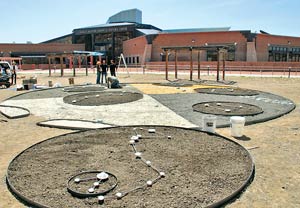Art project combines sand, stars, culture
By Noel Lyn Smith
Navajo Times
WINDOW ROCK, May 17, 2012



(Times photo - Paul Natonabah)
TOP: Artists Chrissie Orr, standing, and Susanna Carlisle, background, work with Melvin Dalgai, a local laborer, on the project outside the Navajo Nation Museum in Window Rock April 30. When the project is complete it will represent the constellations.
SECOND FROM TOP: Melvin Dalgai, kneeling, a local laborer, works on one of the symbols within a huge circle that represents the constellations outside the Navajo Nation Museum April 30.
BOTTOM: Chrissie Orr, an artist from Santa Fe, applies the finishing touches to one of the symbols that represent the night skies April 30 outside the Navajo Nation Museum.
S anta Fe artist Susanna Carlisle gently smoothed the blue sand encased in a steel circle that is part of a large outdoor artwork in front of the Navajo Nation Museum.
Under a cottonwood tree sat large buckets of sand along with a wheelbarrow, rake and ladder.
Carlisle, along with fellow Santa Fe artists Bruce Hamilton and Chrissie Orr, have been working on the piece titled "We Live in Accordance with the Stars," part of eight outdoor art projects that will be placed across the Navajo Nation.
The circle is divided into four sections and filled with sand to represent the four directions - east has white sand, south has blue sand, west has yellow sand and north has black sand.
Sand was collected in 55-gallon buckets from the area of Tsélani-Cottonwood and Balakai Point near Black Mesa, Ariz., and from Blue Clay Point, an area located between Red Lake and Crystal, N.M.
As the sun shined, its light reflected off the large crystals of mica inside Petri dishes. The dishes were used to form the constellations of the Pleiades, Taurus, Orion, Corvus, Scorpio, Ursa Minor, Ursa Major and Cassiopeia.
In order to create the Milky Way, the Petri dishes were glued in groups and affixed to the ground with metal rods.
Each design sits inside smaller dark brown circles, made from compost. The artists mixed the compost with seeds in hope flowers will grow around the patterns.
The piece includes seven silver domes that represent Jupiter, Venus, Sun, Moon, Mercury, Mars and Saturn and were positioned to show the planets' alignment during the summer solstice.
Orr, Carlisle and Hamilton collaborated to develop and construct the piece.
They also worked with Robert Johnson, the museum's cultural specialist, to learn about the constellations in Navajo culture and to unite the significance of the western and Navajo constellations.
The project is a partnership between the museum, New Mexico Arts' Art in Public Places program and the Museum of Contemporary Native Arts in Santa Fe.
A second piece will be installed at the museum. Additional art will be at the Navajo Nation Zoo, Holiday Inn Canyon de Chelly and Canyon de Chelly National Monument Visitor Center, both in Chinle, Chevron McKinley Mine in Tsé Bonito, N.M., Diné College Library in Shiprock and Original Sweetmeat Inc. in Waterflow, N.M.
Each year, the Art in Public Places program partners with a local community to commission up to 10 temporary, visually engaging and conceptually rich environmental artworks to be displayed for a short-term exhibition.
At the end of the exhibition, the artwork is disassembled and removed, leaving no trace.
The eight pieces will be on display from May 18 to mid-September.
The program also brings public art to communities that may not have money to build such displays, said Chuck Zimmer, the program manager.
Since the program started in 2005, this is the first time the program has partnered with an entity outside of New Mexico and on tribal lands.
Zimmer called the collaboration a "unique" collaboration and it provides a learning opportunity for non-Native and Native artists.
That circumstance was one reason Orr, Carlisle and Hamilton submitted their proposal.
"It's about producing something that is culturally relevant in a community and on a certain site," Orr said.
The group arrived here April 27 and worked to collect materials and to construct the piece.
People stopped and asked the artists about the project and sometimes they would watch, Hamilton said.
"It has a sense of discovery about it," he said.
They also filmed the construction with time-lapse photograph with plans to release the footage online.
Clarenda Begay, the museum's curator, and Eunice Kahn, the museum's archivist, worked to bring the project to the Navajo Nation.
"It's for the Navajo people to learn about the artwork from the Navajo perspective," Begay said.

